Beth Kanell's Blog, page 25
April 13, 2012
Clues About an Intriguing Building, Montpelier, Vermont
Sometimes 90 percent of the historical research is done before I begin writing a book. At other times -- and this is one of them -- about 30 to 50 percent is done in advance, and the rest of it is a constant pressure of interest and investigation as the narrative of the story unfolds.
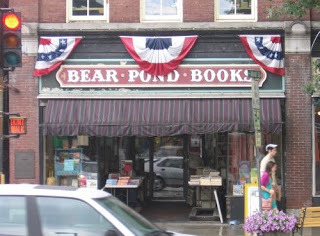 VPR news photo by Bob KinzelFor the new book ALL THAT GLITTERS, featuring teen detective Lucky Franklin, I'm writing a chapter every three days on a public site, Wattpad (see yellow box in right-hand column of this blog page). There are two particular settings involved in the book, other than the modern hospital where Lucky's gunshot-wounded dad is recovering. I chose them for their intriguing past. One is the Vermont State House; the other is the Blanchard Block, which once included the town's Opera House. Now it's the home of the amazing shop Bear Pond Books, a real store whose owners are guests in the novel (smile).
VPR news photo by Bob KinzelFor the new book ALL THAT GLITTERS, featuring teen detective Lucky Franklin, I'm writing a chapter every three days on a public site, Wattpad (see yellow box in right-hand column of this blog page). There are two particular settings involved in the book, other than the modern hospital where Lucky's gunshot-wounded dad is recovering. I chose them for their intriguing past. One is the Vermont State House; the other is the Blanchard Block, which once included the town's Opera House. Now it's the home of the amazing shop Bear Pond Books, a real store whose owners are guests in the novel (smile).
Here's a bit about the structure, from the Central Vermont Walking Tour page:
Well, how could I resist?
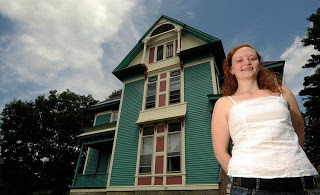 Megan Morse at architect George Guernsey's house. Photo by Jay Ericson.But tracking down information goes one step at a time, and that's not quite enough for the level of detail I need for this story. So the next step, for me, is to track the architect mentioned, George Guernsey. Happily, I've found that a Norwich University student, Megan Morse, began a survey of Guernsey's work in 2009. In fact, here's a photo of Ms. Morse at Guernsey's Montpelier home.
Megan Morse at architect George Guernsey's house. Photo by Jay Ericson.But tracking down information goes one step at a time, and that's not quite enough for the level of detail I need for this story. So the next step, for me, is to track the architect mentioned, George Guernsey. Happily, I've found that a Norwich University student, Megan Morse, began a survey of Guernsey's work in 2009. In fact, here's a photo of Ms. Morse at Guernsey's Montpelier home.
Onward!
 VPR news photo by Bob KinzelFor the new book ALL THAT GLITTERS, featuring teen detective Lucky Franklin, I'm writing a chapter every three days on a public site, Wattpad (see yellow box in right-hand column of this blog page). There are two particular settings involved in the book, other than the modern hospital where Lucky's gunshot-wounded dad is recovering. I chose them for their intriguing past. One is the Vermont State House; the other is the Blanchard Block, which once included the town's Opera House. Now it's the home of the amazing shop Bear Pond Books, a real store whose owners are guests in the novel (smile).
VPR news photo by Bob KinzelFor the new book ALL THAT GLITTERS, featuring teen detective Lucky Franklin, I'm writing a chapter every three days on a public site, Wattpad (see yellow box in right-hand column of this blog page). There are two particular settings involved in the book, other than the modern hospital where Lucky's gunshot-wounded dad is recovering. I chose them for their intriguing past. One is the Vermont State House; the other is the Blanchard Block, which once included the town's Opera House. Now it's the home of the amazing shop Bear Pond Books, a real store whose owners are guests in the novel (smile).Here's a bit about the structure, from the Central Vermont Walking Tour page:
2. Blanchard Block, 67-77 Main, 1833-4 and 1890This impressive block still dominates this section of Montpelier. It was the first and tallest example in town of this type of commercial architecture which remains a major component of so many "downtowns" in America. The architect, George Guernsey, designed attractive storefronts, as well as a full-sized auditorium, known as the Blanchard Opera House. Unusually fine musical entertainment graced the stage largely because it was located between Boston and Montreal and seated 800 people. The building was extended on the right to provide a larger stage and space for the Brooks Post G.A.R., but by 1910 the hall closed permanently, heralding the coming of the moving pictures. The upper floors are now all used for offices and apartments; little evidence remains of the stage and galleries.I have confirmation from two different sources that the Opera House used to host the visiting circuses. Now, picture this lovely performance venue on the SECOND FLOOR of the structure -- and add to your mind's-eye image the fact (confirmed!) that the elephants, as well as other performing animals, used to wall UP THE STAIRS to meet their audience!
Well, how could I resist?
 Megan Morse at architect George Guernsey's house. Photo by Jay Ericson.But tracking down information goes one step at a time, and that's not quite enough for the level of detail I need for this story. So the next step, for me, is to track the architect mentioned, George Guernsey. Happily, I've found that a Norwich University student, Megan Morse, began a survey of Guernsey's work in 2009. In fact, here's a photo of Ms. Morse at Guernsey's Montpelier home.
Megan Morse at architect George Guernsey's house. Photo by Jay Ericson.But tracking down information goes one step at a time, and that's not quite enough for the level of detail I need for this story. So the next step, for me, is to track the architect mentioned, George Guernsey. Happily, I've found that a Norwich University student, Megan Morse, began a survey of Guernsey's work in 2009. In fact, here's a photo of Ms. Morse at Guernsey's Montpelier home.Onward!
Published on April 13, 2012 10:18
April 2, 2012
Birth Certificates, Farm Locations, Single Parenting, and More
 http://www.ancestry.com/1940-census This is a quick bonus post, to accompany today's release of 1940s-era material by Ancestry.com -- which is where I generally go to find the documents that can confirm or reject a picture I'm forming of a particular time in US history. Today I took a look at that collection's Census enumeration maps, to see how they might fit into my search for "Little River Farm," where I think my mother lived in the 1940s.
http://www.ancestry.com/1940-census This is a quick bonus post, to accompany today's release of 1940s-era material by Ancestry.com -- which is where I generally go to find the documents that can confirm or reject a picture I'm forming of a particular time in US history. Today I took a look at that collection's Census enumeration maps, to see how they might fit into my search for "Little River Farm," where I think my mother lived in the 1940s.Most of the time when I'm using this website, though, it's for work on novels that are just coming together in my planning: I have one in mind that's set in the late 1800s on Cape Cod, as the whaling industry waned. It goes with a woman whose life I know the outlines of: married to a whaling man, widowed in her early 20s while expecting her second child, then starting her own business, which (in real life!) would grow to one of the largest in Provincetown. This isn't even on my "wall maps" in my writing room yet (three or four other books are getting written before then!), but I'm filling files with the documents that go with the story. And the new 1940s-era material will help with the second half of the novel.
So much for the notion that writers "just imagine" their stories! Some do ... but for me, the process usually begins with a real moment in time, and a few people whose life decisions at that moment fascinate me.
PS: From the Ancestry folks:
The National Archives and Records Administration will open the 1940 U.S. Federal Census on April 2, 2012—the first time this collection will be made available to the public. Once we receive the census, we will begin uploading census images to our site so the public can browse them. Initially, this collection will be what we call a browse-only collection. This means a person can scroll through the pages of the census districts much like you would look at a microfilm or a book. At the same time, we will be working behind the scenes to create an index of the census that will eventually allow people to search for their family members by name as they currently can with all other censuses on . Note also that the 1940 U.S. Federal Census will be accessible free of charge throughout 2012 on .
Published on April 02, 2012 11:41
April 1, 2012
Welcome to April: National Poetry Month
 Strawberry plants are waking up!After the April Fooling of the morning is done, it's a great day to sign up for receiving a strong poem in the e-mail mailbox each day this week, thanks to the Knopf publishing group, which is featuring work by Jack Gilbert today (perhaps all month?). Click here and enjoy!
Strawberry plants are waking up!After the April Fooling of the morning is done, it's a great day to sign up for receiving a strong poem in the e-mail mailbox each day this week, thanks to the Knopf publishing group, which is featuring work by Jack Gilbert today (perhaps all month?). Click here and enjoy!Here's one of mine, a "sequence" made from poems that I wrote to place on plants I contributed for a local fund-raising plant sale. See if you can figure out what the plants were ...
LOW LIGHT, WATER ONCE A WEEK
My mother gave me one of these:"for your first apartment," she said(graciously forgetting the student one)and tagging the plant with bothmy name and his: "For the Two of You."Its green stems cascaded from her oldblue teapot, chipped at the spout. In a corner of the bare kitchenit pretended that I could keep house.No harder to pretend the realms of "wife"than to forget the quarrels overheard,all those years in my mother's home:time, like the green cuttings,transferred to the next generation.
WATER ONCE A WEEK, LOW LIGHT
This one will grow: In spite of neglect,and all the better if you forget it sometimes,it will multiply in stems and leaves and strandsassuring you that all your mistakesare forgivable by someone, somewhere.You can even share it – take cuttings,set them jauntily in a jar of water,see them sprout roots. Your best friendwill always remember: This is the oneyou gave to her, saying, "Now we aresisters, now we are twins. Love always."
OUTDOOR, PARTIAL SUN
These happy faces, purple and gold, will spreadwithout attention – you only need to set them gentlyinto a bed that's not too crowded, read to thema short and kind story, give some water(not too much). Then walk away, read a book,have a summer life – by the last page,they will have seeded themselvesinto another season. Rejoice! Unlike children,they ask little, need nothing, exceptyour permission.
NEW HOME WANTED
This plant needs a strong vertical spaceand a little support: It can't be trimmedbecause its life depends on standing tall.Years ago, my girlfriend gave it to me,warning me: "The nickname is …mother-in-law's tongue!" Sharp, deliberate,as if a spouse's mother always camewith resentments. I was lucky: Mine werehappy to see me take over, giving mefavorite recipes, old photos, ways to lovetheir boys. But now, I confess, I've hadmy share, and this tall plant (which lovesa dim corner) needs a new home. Is thereroom for her in your collection? She promisesnever to speak too loudly, and alwaysto thank you, for taking her in.
WILLOW, BUT NOT WEEPING
If you have a very wet spot in the yardhere is your candidate to correct the situation:a willow, not the weeping sort, but quick-growing, happily rooting in puddles,soaking up the overflow and holding even a slopein place. Expect spring "pussy-toes" at the tipsof the growing twigs. Believe it or not,five years from now this tree will standsix feet tall or more, bushy, green, glorious,a summer adornment. Aren't you lucky?
Only G-d could have an idea this good.
MINT JULEPS AND MORE
Summer! Bare skin, sweat, sun on your shoulder:that's why this ardent cluster of mintis meant for the June garden, sproutinginto the hot afternoons ahead. Make iced tea,squeeze lemons, stir up iced pitchers ofrelief – and set a sprig of mint in every glass.How to plant it? Choose a cool, shady placewhere there's room to spread, and let it grow.Like the morning after a headache,it feels so good. It smells so good. It grows,like a weed, exuberant and hardy. Life is hard.But mint is easy. Thank goodness,something finally rewards us just forbeing.
BK
Published on April 01, 2012 10:22
Goodbye to March 2012
 Sometimes life provides "coincidences" that couldn't be believed in a novel. Really. (There's a saying that I like: "Coincidence is God, acting anonymously.")
Sometimes life provides "coincidences" that couldn't be believed in a novel. Really. (There's a saying that I like: "Coincidence is God, acting anonymously.")My mother's heart stopped beating on March 26, 1984 -- was restarted after "too long" and mercifully failed again in the wee hours of the next morning. Her unexpected death at age 53, when I was still a very young woman, heavily pregnant with my second child, meant I had a lot of grief to handle -- and yet didn't want to give way to it very far, because I wanted to keep my almost-born baby healthy, as well as take good care of my toddler and husband.
This past week, on March 26, our community was shattered by the murder of a wonderful 33-year-old science teacher and mom and engaged member of multiple communities -- and I cried. A lot. So did a lot of other people. I actually didn't even think of my mom's death until five days later, when our local paper printed a banner headline "LOVE WINS" along with the dates of Melissa Jenkins's life.
In so many ways, our region has insisted that love win this time. It's for Melissa, who taught people around her the saying, "We need to love those the most who need us the most."
Most poignant to me today are: (1) The recollection of overhearing a busy woman Friday, as her friends tied pink balloons to parking meters, so that even the rough March downtown sidewalks proclaimed Melissa as the area adopted her favorite color. This woman, racing past a balloon-tying friend, called out, "I've made pink roses for us to wear in the bar tonight." (2) The lingering pink balloons, tied to railing, fenceposts, mailboxes, and more.
The stories that matter are often true stories. The story of Melissa Jenkins and Vermont matters. And it always will.
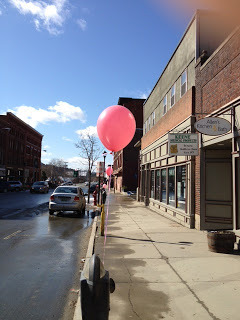 PS -- The front page of the Burlington Free Press shows a number of male political leaders greeting President Obama on Friday in Vermont. My husband pointed out their pink shirts. "For Melissa," he said. Love wins.
PS -- The front page of the Burlington Free Press shows a number of male political leaders greeting President Obama on Friday in Vermont. My husband pointed out their pink shirts. "For Melissa," he said. Love wins.
Published on April 01, 2012 09:59
March 25, 2012
March Rewards: Maple Sugar, Parsnips, Writing Time
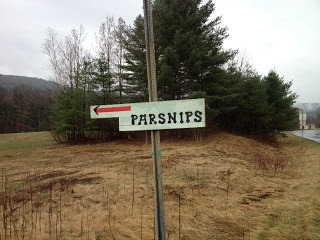 Spring veggies for sale; sign in Barnet, Vermont, today.Rain, steady and soaking. The "pond" (really a good-sized lake) down at the foot of the ridge is slowly releasing its layer of ice, from the north side first (because that gets the steadiest sunshine across the open space). If we get a bit of wind, I think it will all collapse today. "Ice out" is a significant marker of the season, and in the old logging days it would mean the winter's worth of treetrunks, coming down the Connecticut River in flotillas big enough to clog the river for weeks at a time, sometimes longer.
Spring veggies for sale; sign in Barnet, Vermont, today.Rain, steady and soaking. The "pond" (really a good-sized lake) down at the foot of the ridge is slowly releasing its layer of ice, from the north side first (because that gets the steadiest sunshine across the open space). If we get a bit of wind, I think it will all collapse today. "Ice out" is a significant marker of the season, and in the old logging days it would mean the winter's worth of treetrunks, coming down the Connecticut River in flotillas big enough to clog the river for weeks at a time, sometimes longer.The unusual March warmth this year didn't do any favors for the maple sugaring season. To gather maple sap that can be boiled to the sweet syrup, you need the seasonal "up and down" surge of sap through the trunk, and that only happens when days linger above freezing temperatures, and nights fall below freezing. Too much warmth causes the trees to start to bud instead, and that changes the sap and makes it "buddy" tasting -- no good for syrup.
In The Secret Room there's plenty of information about what the Underground Railroad "looked like" in Vermont in the 1850s. (Hint: It wasn't underground. Jane Williamson, director of Rokeby, the Quaker-inspired farm in North Ferrisburgh, Vermont, where the farmers documented the fugitive African Americans passing through, says it ought to be called the "Aboveground Railroad" in Vermont!)
In a separate novel, The Long Shadow (not yet published), I followed the action during 1850 in the lives of three teenaged girls living nearby. The book actually begins in sugaring season. The little town of Danville, Vermont, had a wide-open market for the maple sugar made there, because of the politics of the time: Conventional sugar was made from molasses, which required "slave labor" then. Maple sugar, though, was made locally, without abusing or oppressing people (or animals). So if you lived in 1850s Vermont and felt strongly about the abolition of slavery, you could take a stand in your own kitchen by demanding maple sugar and banning store-bought "cane" sugar.
I've declared a sugar-free day today in my kitchen, to honor that 1850s decision by local cooks.
As you can see from today's photo, there's another "spring crop" being offered locally: parsnips. This root crop sweetens significantly over the winter, if you can save it that long, and it makes a great March vegetable. I'm waiting for my lower garden to thaw, so I can dig up another root crop: horseradish.
More on that, another day. Today I've got more writing to do, and need to take advantage of the rainy afternoon!
Published on March 25, 2012 09:35
March 23, 2012
Interlude: Slowly Planning a Later Novel
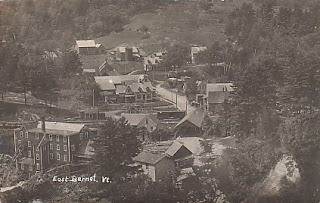
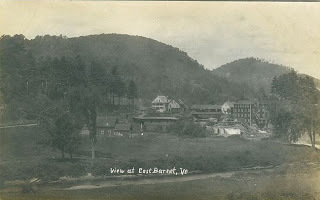
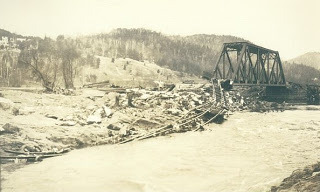 One part of my own "writing process" is that there's always another novel coming together in the background. Driving in today's lovely springy weather took me through East Barnet, Vermont -- where the depot in the days of the passenger trains was named "Inwood." Here are three postcard views from the wonderful Northeast Kingdom postcards site provided by Janice Boyko -- one showing a railroad washout, and the other two, views of East Barnet village. Thanks to Marvin Roy, I also have a copy of a scrapbook from a family connected with the huge mill structure you can see in the postcards, home to the Roy Brothers croquet factory.
One part of my own "writing process" is that there's always another novel coming together in the background. Driving in today's lovely springy weather took me through East Barnet, Vermont -- where the depot in the days of the passenger trains was named "Inwood." Here are three postcard views from the wonderful Northeast Kingdom postcards site provided by Janice Boyko -- one showing a railroad washout, and the other two, views of East Barnet village. Thanks to Marvin Roy, I also have a copy of a scrapbook from a family connected with the huge mill structure you can see in the postcards, home to the Roy Brothers croquet factory.  Weather and wooden structure conspired to destroy the factory three times, and the railroad only runs a freight train now (twice a day). The village is more of a whisper, a bend in the road with a cluster of homes closer together. But there's a story lurking there, and each time I drive through, a little more of it will come clearly. In a few years, I'll know the characters and the plot.
Weather and wooden structure conspired to destroy the factory three times, and the railroad only runs a freight train now (twice a day). The village is more of a whisper, a bend in the road with a cluster of homes closer together. But there's a story lurking there, and each time I drive through, a little more of it will come clearly. In a few years, I'll know the characters and the plot.But for today, I know the title: Inwood.
Published on March 23, 2012 11:05
March 21, 2012
Charles Dickens and 17 Pages Per Week: Serial Fiction
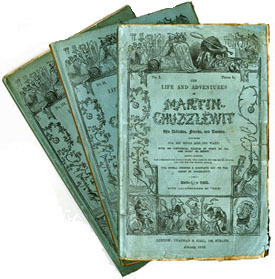 Publishing a novel in chunks in a newspaper turns out to have been a tax dodge -- by printing on a different paper size, newspapers in Victorian England could claim they were issuing "brochures" and thus dodge a special tax assessment that would have struck them as ordinary news publications. What a break for Charles Dickens! Plus, the author of Great Expectations, Oliver Twist, and The Christmas Carol, as well as A Tale of Two Cities, had three necessary skills for releasing his books chapter by chapter: (1) He could write roughly equal-sized chapters, necessary for the nuts and bolts of such publishing. (2) He was a master of the end-of-chapter cliffhanger. (3) He could reliably write 17 pages per week.
Publishing a novel in chunks in a newspaper turns out to have been a tax dodge -- by printing on a different paper size, newspapers in Victorian England could claim they were issuing "brochures" and thus dodge a special tax assessment that would have struck them as ordinary news publications. What a break for Charles Dickens! Plus, the author of Great Expectations, Oliver Twist, and The Christmas Carol, as well as A Tale of Two Cities, had three necessary skills for releasing his books chapter by chapter: (1) He could write roughly equal-sized chapters, necessary for the nuts and bolts of such publishing. (2) He was a master of the end-of-chapter cliffhanger. (3) He could reliably write 17 pages per week.This month I'm doing be best to follow in Dickens' footsteps. I'm writing a detective novel, featuring Vermont's own "Nancy Drew"-style character, college freshman Felicity "Lucky" Franklin, called home to probe the shooting of her father (and her mother's arrest on suspicion of murder). It's called ALL THAT GLITTERS. I'm doing it on a public website, Wattpad, where hundreds (maybe thousands) of other authors are also writing chunks of fiction -- many of them paranormal romances. I can see how audiences would treat such books sort of the way the Americans did the work by Dickens, most especially chapters from The Old Curiosity Shop, in which readers knew in their hearts that the beloved character Nell was probably going to die. A Time Magazine review of The World of Charles Dickens by August Wilson began:
When Fyodor Dostoevsky was sentenced to four years in a Siberian labor camp, he requested only one kind of reading matter: books by Dickens. In mid-19th century New York, ships arriving with the latest installment of Dickens' The Old Curiosity Shop were met by anxious cries from the dock: "Is Little Nell dead?"Anyone who's written for a daily newspaper, or a demanding college English professor, knows that writing 17 pages per week isn't that unusual. Especially if you're getting paid for it, and you don't have to do much of anything else in your days/nights.
The challenge is when you're not getting paid a bit, so your "day job" has to keep taking most of your time -- you're still cooking for your family -- you've got car appointments and doctor visits and the yard needs your care ... Heavens, it gets interesting that way!
Still, I'm carving out my couple of hours every three days, to write the next chapter and post it. I've complete six of them this way.
And I've discovered the catch: I'm starting to realize the things I should have added to the earlier chapters. I've got notes on envelopes, napkins, grocery lists -- "Go back and put in ..." -- and I'm trying to hold in my mind, very gently so they won't go stale, all the twists and deepenings that I want to add in chapters 12, 24, 33. How the dickens did Dickens pull it off?
Don't stop now. Check in for chapter 7 on Friday evening. Oh, you haven't read the first six yet? Don't panic -- just slip on over to Wattpad and get reading. I promise what one of my correspondents is now calling Kanell Kliffhangers. How long will Lucky Franklin's luck hold out, as she investigates criminal behavior that's already blown a bullet through her own dad?? More soon ...
Published on March 21, 2012 18:11
March 18, 2012
"Write Like a Writer": Strong Sentences
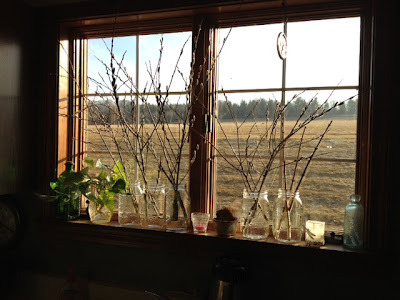 Pussywillows and forsythia rooting at the east window.Many thanks to students and teachers at the St. Johnsbury (VT) school, where three groups joined me last week for a session of "Write Like a Writer" focusing on strong opening and closing sentences. Students prepared ahead of time, using their writing notebooks to pull this together:
Pussywillows and forsythia rooting at the east window.Many thanks to students and teachers at the St. Johnsbury (VT) school, where three groups joined me last week for a session of "Write Like a Writer" focusing on strong opening and closing sentences. Students prepared ahead of time, using their writing notebooks to pull this together:Consider yourself a collector of important sentences. Please bring ON PAPER to our workshop:
After sharing readers' choices of strong opening and chapter-ending sentences, we used a "white board" (actually we used "smart boards," my first experience of them -- need some practice to have better handwriting on these!) to test a couple of sentences that students suggested as "needing to be stronger."
A. Two "chapter opening sentences" that you like -- one from The Secret Room and one from another book that you like.
B. Two "chapter ending sentences" that give you a hint of what's coming next -- one from The Secret Room and one from another book that you like.
C. Two sentences from a piece of your own writing that you'd like to make stronger.
D. A three-sentence description of what breakfast was like at your house recently. You can be "factual" or "fictional" in your description, but it should be interesting in some way! We won't get to look at all of these, but we'll do our best. [We only did this in one classroom, and we turned it inside out to create fiction instead, around the idea of foreshadowing the rest of the story, which would involve a sibling leaving for military service. Thanks, Mr. Shepley!]
Among the techniques we used were testing adverbs to see whether they could be replaced with more detailed material; looking at "weak" verbs like forms of "to be" and "to go"; and an exercise called "See the Puppy."
You can try "See the Puppy" yourself: Present your (imaginary) puppy to an onlooker or group of students. React to what the puppy is doing in ways that make it clear there's a live, squirmy, adorable animal there. Recruit students to name the puppy and to describe its appearance. Amazing how quickly these details mount up!
And this is ... exactly the process for developing a character in your writing that you can "see."
By the way, this set of exercises can be adapted to writing nonfiction, too. The underlying idea is: As a writer, you're looking for an effect on the reader. It's OK if the reader is the teacher, or your BFF. But this isn't a diary that's just for the writer -- it's part of a communication process. And it's fun!
[PS -- Special thanks to librarian Beth Mallon, who pulled everyone together and made the schedules work!]
Published on March 18, 2012 08:07
March 14, 2012
Happy PI Day! March 14, 2012
 That's "pi," as in, the Greek letter used for the amazing "irrational" number that forms the ratio between the diameter of a circle and its circumference. If you love math and numbers, you probably already know about Pi Day, too -- today, March 14. It's not a new celebration, since it was invested two decades ago. But it's a lot more fun today, as math becomes one of the pleasures and fun activities of both classrooms and careers.
That's "pi," as in, the Greek letter used for the amazing "irrational" number that forms the ratio between the diameter of a circle and its circumference. If you love math and numbers, you probably already know about Pi Day, too -- today, March 14. It's not a new celebration, since it was invested two decades ago. But it's a lot more fun today, as math becomes one of the pleasures and fun activities of both classrooms and careers.For more information on Pi Day, check out the Pi Day website; you can also connect with others having fun with this, on the Pi Day Facebook page!
Because I love both math and Vermont traditions, I plan to bake an old-fashioned apple-blackberry pie for supper tonight -- and then carefully measure its diameter and circumference, and see how close to "pi" I can get with the tools on hand.
 How about you?
How about you?
Published on March 14, 2012 08:38
March 12, 2012
The Power of One Woman's Actions: Juliette Gordon Low
 Today, and all year really, we get to celebrate the commitment and focused actions of Juliette Gordon Low of Savannah, Georgia, who brought the English notion of Girl Guides (thank you, Lady Baden Powell) to America and organized the first Girl Scout troop here.
Today, and all year really, we get to celebrate the commitment and focused actions of Juliette Gordon Low of Savannah, Georgia, who brought the English notion of Girl Guides (thank you, Lady Baden Powell) to America and organized the first Girl Scout troop here.I was briefly a Brownie, and loved being a Cadette. My mom grew up in hard times, took a two-year degree in nursery-school teaching, and as a mother herself, was committed to making sure her kids got the opportunities she'd missed. She made sure I got to all of my Cadette meetings (at the little brown stone church -- Presbyterian? -- in Montclair, NJ). And in those meetings and my Girl Scout Handbook, I learned how to talk about honor, commitment, and balance: all things that my parents were trying to teach, but without the verbal framework. It shaped my life and still does.
Here's a great site to visit today in honor of 100 years of "growing girls" and service to community, as well as carefully nurtured friendships: http://www.girlscouts.org/gsforevergreen/
And her's the song I've been humming this morning
Girl scouts together that is our songFor more on Juliette ("Daisy") Gordon Low, click here. And here's a wonderful photo:
Winding the old trails, rocky and long
Learning our motto, living our creed
Girl scouts together in every good deed.
Girl scouts together happy are we
Friendly to neighbors far o're the sea
Faithful to country loyal to home
Girl scouts together wherever we roam.
Girl scouts together onward we go
Joining as sisters stronger we grow
Mothers and lawyers, women in space
We know no boundaries, the future's our place.

Published on March 12, 2012 07:16



